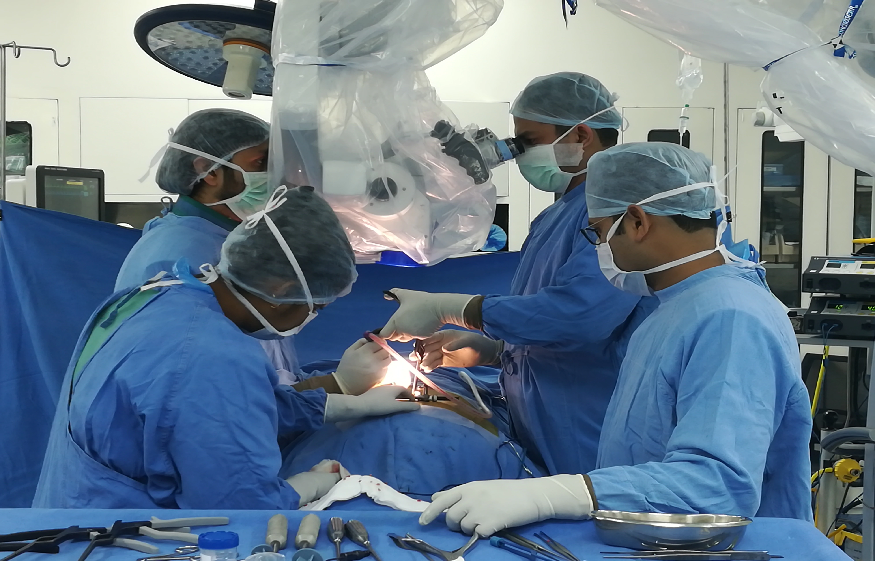Insights on Identifying the Ideal Candidate for Spinal Disc Replacement
5 min read
Spinal disc replacement has emerged as a promising option for individuals with chronic back pain and disc degeneration, potentially offering pain relief while preserving spinal mobility. Patient suitability depends on several factors, including overall health, specific spinal conditions and lifestyle. Dr. Larry Davidson is an experienced spinal specialist whorecognizes key criteria that determine whether spinal disc replacement is the right choice, helping patients and healthcare providers make informed decisions.
Understanding Spinal Disc Replacement and Its Purpose
Spinal disc replacement is a surgical procedure in which a damaged disc is removed and replaced with an artificial disc designed to mimic natural disc movement. This approach aims to relieve pain caused by disc degeneration or herniation while maintaining spinal flexibility, making it a popular alternative to spinal fusion, which restricts movement. Disc replacement is often considered for patients with degenerative disc disease in the lumbar (lower back) or cervical (neck) regions, particularly those who wish to preserve motion at the affected level.
Key Factors in Determining Patient Suitability for Disc Replacement
- Age and General Health
Age and general health play a significant role in determining suitability for spinal disc replacement. Typically, younger patients in good overall health may be considered suitable candidates. However, age alone is not a strict limit; rather, it’s the patient’s physical condition and the presence of other health issues that matter. Conditions such as osteoporosis, uncontrolled diabetes or severe arthritis can complicate recovery and may make disc replacement less advisable. Overall, candidates should have good bone density and no significant comorbidities that could affect surgical outcomes.
- Severity and Location of Disc Degeneration
Candidates for disc replacement typically have one or two affected discs in the lumbar or cervical spine. Single-level degeneration, where only one disc is damaged, is ideal, as it allows for focused treatment with fewer risks. Patients with multiple damaged discs may experience more complex spinal issues, making fusion surgery a more suitable alternative. Additionally, disc replacement is most effective in cases of isolated disc degeneration or herniation without extensive structural abnormalities in the spine. Disc replacement for thoracic spine issues is rare, as this area of the spine generally has limited mobility and may be less suitable for motion-preserving implants.
- Symptoms and Functional Limitations
Ideal candidates are those experiencing persistent pain, limited mobility or neurological symptoms like numbness and tingling due to nerve compression. These symptoms should significantly impact daily activities, work or quality of life and conservative treatments—such as physical therapy, medication or injections—should have failed to provide sufficient relief. Candidates are typically evaluated to determine whether disc replacement may address specific, functionally limiting symptoms that are directly linked to the damaged disc. Individuals with only mild pain or intermittent discomfort may be better suited for non-surgical options.
- Spinal Stability and Alignment
Spinal stability and proper alignment are crucial for successful disc replacement. Candidates are generally expected to have a stable spine without significant spinal deformities, such as scoliosis or kyphosis, which could affect alignment. If the spine is unstable or misaligned, disc replacement could exacerbate these issues. Surgeons use imaging tests to assess stability and alignment, as precise disc placement is necessary to ensure the artificial disc functions correctly. Patients with stable spines are more likely to experience successful outcomes from disc replacement, as proper alignment allows the implant to move naturally within the spinal structure.
- Bone Density and Quality
Good bone density is essential for disc replacement candidates, as the artificial disc must anchor securely to the vertebrae. Patients with osteoporosis or weak bones may not be suitable, as poor bone quality can increase the risk of implant loosening or failure. Bone density is often assessed through imaging tests before surgery, helping determine if a patient’s vertebrae are strong enough to support an artificial disc. Healthy bone density may support recovery, as strong bones could help reduce the risk of complications and support the stability of the disc.
- Lifestyle and Activity Level
Patients with active lifestyles and a desire to maintain mobility may be particularly good candidates for disc replacement. The procedure preserves motion at the affected level, allowing patients to stay more physically active than they might after fusion. However, patients with physically demanding jobs or high-impact activity preferences should be cautious, as excessive strain on the spine can affect the longevity of the artificial disc. Disc replacement may be suitable for active individuals, but they should be willing to follow post-surgical guidelines to protect the implant, avoiding high-impact activities that could compromise its durability.
Who Might Not Be Suitable for Spinal Disc Replacement?
While disc replacement is beneficial for many, it is not recommended for everyone. Patients with advanced spinal degeneration, multilevel disc disease or severe spinal deformities may be better suited for fusion surgery. Additionally, individuals with autoimmune diseases, chronic infections or severe obesity might face higher risks in disc replacement, as these factors can complicate healing and increase the likelihood of complications. Finally, candidates with pre-existing spinal instability or previous spinal surgeries that affect the area of interest may also be less suitable, as these factors may interfere with the success of an artificial disc.
Evaluating Candidacy: The Importance of Medical Consultation
Determining suitability for spinal disc replacement requires a thorough evaluation by a spine specialist. Medical imaging, including X-rays, MRI and CT scans, helps assess the condition of the discs, alignment and bone density. During consultation, the specialist considers the patient’s overall health, specific symptoms and lifestyle goals to create a personalized treatment plan. Open discussions about risks, benefits and realistic expectations are essential in the decision-making process, helping patients choose the option most aligned with their health needs and lifestyle.
Spinal disc replacement offers a motion-preserving alternative to fusion for patients with chronic back or neck pain due to disc degeneration. Ideal candidates are typically younger, active individuals with single-level disc degeneration, good bone density and stable spinal alignment. A comprehensive evaluation by a healthcare provider is crucial to determine suitability, as each case is unique. Dr. Larry Davidson understands that these factors can help patients and providers make informed choices, potentially leading to better outcomes and improved quality of life for those affected by disc-related spinal issues.




